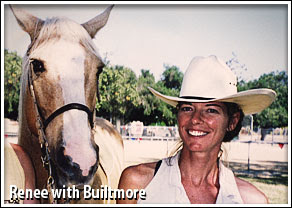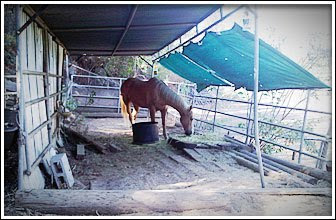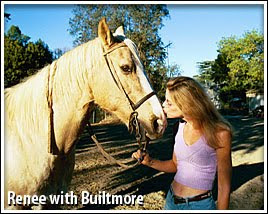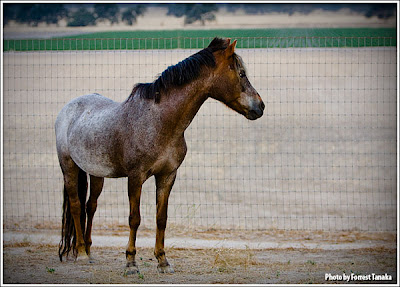During a trip to Fallon, Nevada, in September of 2008, Marlene Dodge of Valley View Ranch Equine Rescue saved the life of yet another horse bound for slaughter in Canada or Mexico. Chubbs, as he is affectionately named, came from a ranch where he was used as a pony horse and packhorse in the mountains. On one pack trip Chubbs was walking along the trail and the ground gave out underneath him causing him to fall off the mountain. As he fell down the hill he knocked out trees and his owner was sure he would not live through the fall. When his owner got to the bottom of the hill Chubbs was standing and grazing like nothing had ever happened! However, as a result of the accident Chubbs was sent to a feedlot auction where he caught the eye of Marlene.
After his rescue from the feedlot and during his time at Valley View Ranch, Chubbs was assessed, ridden, and put up for adoption. Mike Holt from Pleasanton, California came to the ranch, saw Chubbs and had to have him. Mike wanted to give Chubbs the best home he possibly could and intended to ride him on the trail and compete in team sorting. But not long after Mike took him home, Chubbs began limping on his left front foot. He had minor discomfort at Valley View but his shoes had just been pulled so that was the suspected cause of soreness. Mike decided to call in his vet for X-rays after Chubbs didn’t get any better, revealing a fracture on his coffin bone with possible infection. Surgery was suggested as the only possible way to treat the injury. At $2500 just for the surgery, not including aftercare, Mike was saddened to realize he couldn’t afford to give Chubbs the treatment he needed. Marlene agreed to take Chubbs back to Valley View Ranch and try to have him treated.
Marlene needed help to raise the funds to help Chubbs, so she contacted Redwings. Redwings felt the request came under their mission of helping horses in need. Through Redwings’ “Helping Hooves” program, Redwings was able to assist with some of the funds needed to help Chubbs go into surgery. Marlene says, “Redwings was of great support and donated towards his surgery and treatment.” The donations went directly to the veterinary hospital that did the surgery, and then Chubbs was relocated to California Equine Podiatry Clinic in Santa Ynez for some of his after care.
Chubbs had a hospital-plate shoe on his hoof that bolts on and off so that his medicine can be put on the healing wound. The prognosis for Chubbs is very bright, he’s completely sound, and he should be able to partner with Mike in the near future. In fact, the hardest part of his recovery was keeping him quiet in his stall. Marlene and Mike wish to thank Redwings supporters and the veterinarians who have helped Chubbs have a future.
Valley View Ranch has been posting updates about Chubbs on their Web site at www.valleyviewranchequinerescue.webs.com.
Monday, August 31, 2009
Chubbs—From Zero to Hero
Posted by
Redwings Horse Sanctuary
at
9:24 AM
![]()
Labels: Chubbs—From Zero to Hero
Monday, August 24, 2009
Saving Builtmore: A Lesson in Getting Involved
“It is only with the heart that one can see rightly. What is essential is invisible to the eye.”—Antoine de Saint Exupéry
By Leny Freeman Builtmore is more than just a horse—at least for me. Builtmore Harley Davidson fills a chapter in my life that finally closed with a happy ending.
Builtmore is more than just a horse—at least for me. Builtmore Harley Davidson fills a chapter in my life that finally closed with a happy ending.
It began when I met his owner, Renee Davidson, in 2003. We were volunteering to help convicted criminals restore their self-respect. That has nothing to do with horses, but that’s how we met.
One day in April of 2008 Renee called me and said she was looking for people to help her with an illness, and I told her I would. By May, Renee told me she had cancer. She was getting excellent care at City of Hope Hospital, but her cancer wasn’t discovered until it had already metastasized. She had summoned a group of us to help, and with a positive attitude we persistently and consistently helped however we could. For eight months we saw her getting better, and then getting worse. Renee knew she was going to die and was busy putting her affairs in order.
On November 18 at 3:30 p.m. Renee Davidson, in her sunroom overlooking Shadow Hills in the horse country of Los Angeles, departed her body. She had properly left all her affairs in order save one: Builtmore. She had loved Builtmore and desperately tried to find someone to take him. But giving away a 22-year-old unrideable horse—especially after the market crash the prior month—was not easy.
We found a woman who took care of him along with her own horse, Jack, on Renee’s property, but in April of 2009 she had to move Jack. Builtmore whinnied for Jack all day, but he was all alone with no one to care for him. That’s when I stepped up and said to Jesus, “Leny Freeman, Angel Apprentice, reporting for duty, sir.” Me and my big mouth; I knew nothing about horses.
That’s when I stepped up and said to Jesus, “Leny Freeman, Angel Apprentice, reporting for duty, sir.” Me and my big mouth; I knew nothing about horses.
That ignorance did not last long. I found out just how dismal a horse’s life can be if he can’t make his living. I called various horse rescue centers, but they all wanted horses that could earn their keep being rented out.
I really need to acknowledge Renee’s neighbor, Jerri. I was very lucky to have her there teaching me so much about horses. She fed Builtmore in the morning and I fed him after work every night, and twice on weekends. I did all the cleaning, so I could tell if he was being fed properly. With her help Builtmore had all his needed vaccinations and a proper diet program. I had never jabbed a horse in the ass with a hypo-dermic needle before, but got it done for Builtmore. He didn’t have shoes but needed his hooves trimmed, so I found a good farrier named Ron who trimmed him up and took the stress off his navicular bone.
In May I spoke to the owner of a ranch who said that people were letting horses they couldn’t afford anymore into the hills to fend for themselves. I was outraged at such irresponsibility. She advised that I put Builtmore down, but I knew the answer to that was “no.” Builtmore wasn’t limping and didn’t appear to be in pain. I would only put him down to end suffering—not to solve my problem. I posted a hundred flyers all over Shadow Hills and other horse properties to find someone of means who wanted a companion for another lonely horse. My criteria for choosing someone for Builtmore was: (1) someone who could care for him better than I, and (2) he had to be in the company of other horses.
In response to my ads I received two types of calls: those who had serious questions on health, lameness, medications etc., to which I was honest and they declined. The second type of call was like, “Hey man, you giving away a free hoss? I’ll take him.” I don’t think so. I’ve seen people with that attitude before, and they ride horses into the ground and then sell them for dog food. No. NO. NO!!! That was not the future I would allow Builtmore—until I find the right match, the horse is mine.
After a month of seeing Builtmore every day, I stopped returning calls from good people who might take him. The inevitable had happened: I was in love with a horse. From May to August, I tended him every day—grain hay in the morning, Timothy at night with grain, and a little psyllium for good colic prevention. His shack was about to fall down, so my buddy and I winched it back and added braces and a shade cloth for the summer. We added fly traps that were always filling up. We gave him carrots to keep him occupied, and we put fly lotion on his face. If you’re not experienced and confident with horse control, carrots are the next best thing.
From May to August, I tended him every day—grain hay in the morning, Timothy at night with grain, and a little psyllium for good colic prevention. His shack was about to fall down, so my buddy and I winched it back and added braces and a shade cloth for the summer. We added fly traps that were always filling up. We gave him carrots to keep him occupied, and we put fly lotion on his face. If you’re not experienced and confident with horse control, carrots are the next best thing.
A trail goes up from his paddock to Renee’s house that now has renters who also love Builtmore. He was used to coming up to see Renee, so he still came looking for her and to hang out on the patio to keep cool in the summer. As horses do, he would always leave something behind, so cleaning their patio became another duty. They’re lucky he didn’t have a house key.
By early August, I knew I would have to find a permanent home for him. My company was laying off people, and my job was looking rather risky. I didn’t want to be in a position of having to get rid of Builtmore if I lost my job. I wanted to keep him, but his well-being was more important. Reluctantly, I made a few phone calls; one was to Ron the farrier.
On August 12 I got a call from a guy named Tom Hill—a friend of Ron’s—who heard I was giving away a horse. I asked a stupid question: “Do you know anything about horses?” It turns out that Tom Hill is a retired farrier and for the last seven years has been breaking wild mustangs to sell them when they’re ready. Does he know anything about horses? I can only roll my eyes at that question.
Tom came over to check him out “from the feet up” and said he wasn’t as bad as I thought, then took him for a test ride. When I came to feed Builtmore that evening he was still gone, so I did my tasks and left. A while later I got a call from Tom: “You’re missing a horse,” he said.
“Should I call the Sherrif?” I asked.
“No,” he laughed, “He’s over here standing in wood shavings, eating hay, and happy as hell. He didn’t take a lame step all the way home, he rides great. He’s gentle and excellent for my girlfriend.”
I was sad but happy at the outcome; it was for the best—Builtmore is in perfect hands. My goal of finding him a loving home with better care and with other horses has been surpassed beyond my wildest hopes. It’s a perfect match. Tom and Jean are happy, Builtmore is happy, Jerri is happy, and I am happy.
And Renee is happy. This was all for you, Renee.
In closing, I want to be brutally honest with you. When Renee first called for help, my first instinct was to ignore it. Why? Because it was uncomfortable and inconvenient. But I could not ignore it. So I started helping and found myself giving more help to her than I ever imagined I would. Something was driving me—a higher power if you will, or perhaps it was my power. I thought that as long as I’m helping her, she’d get better and live; but that was not to be. I watched the cancer take her and there was nothing I could do to change that.
I was just getting over that when Builtmore’s plight came to my attention, and I knew I couldn’t ignore that either. Once again, I was driven from within. Inconvenient? Yes. Expensive? Absolutely. But it was a duty and an honor. Had I ignored Renee and Builtmore in their time of need, I would be locked in a trap of justifications and excuses, and trying to make myself “right” for the rest of my life. Thank God I did the right thing, for I’m a different person now. Despite the heartbreak and sadness, I am very proud.
You may find situations you can’t ignore either. The only way to fix it is to do something about it. You might not be able to save the whole world, but you can save part of it. The part of the world you save is your choice. A wise man once wrote, “A being is as valuable as he can help others.” So help some part of the world, and you will feel your value.
Leny Freeman
Sunland, California
Posted by
Redwings Horse Sanctuary
at
8:34 AM
![]()
Saturday, August 22, 2009
Horse Heaven Art Sale
Galerie Plein Aire hosts an art show that benefits Redwings Horse Sanctuary on Sunday, September 27 from 5 p.m. to 8 p.m. This event features a silent auction with a subsequent online auction, and 50% of the profit goes to Redwings, and 50% goes to the artist. Wine and finger foods will be served. Galerie Plein Aire Gallery is located in Carmel on Dolores between 5th and 6th. The theme of the show is “Horses or Great Outdoors.”
Posted by
Redwings Horse Sanctuary
at
6:52 AM
![]()
Tuesday, August 18, 2009
Redwings Spring Raffle
We congratulate the winners of the 2009 Redwings Spring Raffle, and heartily thank everyone who participated. Though each ticket costs only $5, your participation raises many thousands of dollars for the Redwings horses, making this one of the most important Redwings fundraisers of the year.
Grand Prize: Marilyn R. of Long Beach, California
Four nights in a cottage in Carmel, two tickets to Monterey Bay Aquarium, and two horse rides at Pebble Beach Stables
First Prize: Carol S. of Carmel, California
Framed horse print by Cyndra Bradford
Second Prize: Mary S. of San Francisco, California
Framed photo of Redwings mustangs by Forrest Tanaka
Third Prize: Harriette M. of Sunland, California
Italian silk scarf with horse motif
Four Prize: Sharon M. of Anaheim, California
Redwings Bucks gift certificate worth $40 of Redwings merchandise
Posted by
Redwings Horse Sanctuary
at
9:00 AM
![]()
Friday, August 7, 2009
Symphony's Legacy
 Symphony, a little Welsh Pony who came to us in August of 2008 has left our Lockwood ranch for UC Davis School of Veterinary Medicine. After a long life as a friend and teacher to children, then a teacher to Redwings visitors, she now fulfills one last duty: to help other horses suffering from an unusual disease.
Symphony, a little Welsh Pony who came to us in August of 2008 has left our Lockwood ranch for UC Davis School of Veterinary Medicine. After a long life as a friend and teacher to children, then a teacher to Redwings visitors, she now fulfills one last duty: to help other horses suffering from an unusual disease.
Symphony came to Redwings in unusual circumstances for us. She had never been abused or neglected; not in the least. She started her working life as a child’s hunter/jumper show pony, and then became a much-loved gentle lesson pony for fifteen years where she was a favorite of ranch boarders and students alike.
Unfortunately for her and the many children who learned from her and loved her, she was then diagnosed with an unusual degenerative bone condition called silicosis osteoporosis. This condition causes her bones to become brittle and easily broken. Her days of being ridden were over. Her owners could not afford to board a non-working horse, and came to Redwings to help.
Symphony presented an unusual situation for Redwings. We normally only rescue horses who have been abused or neglected and cannot find another home, and Symphony certainly did not fit that profile. However, part of our mission is to help educate people about horses, and Symphony’s condition would help us have a discussion about this disease with our supporters. Additionally, her friendliness and gentleness would bring a great deal of enjoyment to our staff and visitors. She arrived, full of life, at her permanent home at the Redwings ranch in Lockwood on August 14, 2008. However, we knew her time with us would likely be too short.
Symphony was everything we expected her to be: perky and obviously enjoying being in the grass turnouts. We carefully chose a stall for her because dust is very harmful to horses suffering silicosis. Veterinarians suggested putting Symphony on a low dose of bute, a painkiller, to help keep her comfortable.
Horses with silicosis typically live a year past the diagnosis before the pain becomes unbearable. Just shy of a year past Symphony’s diagnosis date, she was showing signs of discomfort. Her right shoulder began to deform and was sticking out of her shoulder joints, causing her more pain. Our farriers trimmed her feet so that she stood more on her heels; veterinarians changed her medicine to Banamine, a stronger anti-inflammatory, and the staff kept her out of the grass turnout for fear that her running and playing could cause her to break a bone. She clearly would soon be in more pain than anyone could ease, and our staff and veterinarians began to discuss her options, including euthanasia.
Our staff had been in contact with Dr. Murray from the UC Davis School of Veterinary Medicine to see whether her condition could provide valuable research for them. We also chose a date for her to be euthanized if she was not accepted into their program. Fortunately for everyone, Dr. Murray called our ranch to say that Symphony was accepted, and to begin her preparations.
To prepare Symphony for the program, Dr. Baker from Monterey County Equine gave her medicines to help the researchers analyze her bones more easily. During her last fifteen days at our Lockwood ranch, she received extra attention from visitors and her friends, with extra groomings and horse cookies as a bittersweet sendoff.
On August 3, Redwings staff brought Symphony to UC Davis where their staff showed us where she would live. The veterinary staff at UC Davis will use various diagnostic tools such as ultrasound and bone scans to test their effectiveness in diagnosing this disease, as well as doing a detailed analysis of her blood to see how blood tests might help in early diagnosis of the disease in other horses. During these tests, she will be sedated to minimize her discomfort. Their staff will then humanely euthanize her, and veterinarians and veterinary students will examine her bones and other tissue to help with the research of this disease, and will preserve them for future research.
Symphony has had a magnificently full life. She was the pride of a child for showing, a gentle riding teacher for many other children, and now she provides crucial research data needed to prevent suffering in other horses that share this disease.
To Symphony, a pony who touched so many lives:
SOMEWHERE
Author: Unknown
Somewhere, somewhere, in God's own space,
there must besome sweet, pastured place
Where creeks sing on, and tall trees grow; some paradise where horses go.
For by the love that guides my pen, I know great horses live again.
Thank you, Symphony
From all of those you have touched.
Posted by
Redwings Horse Sanctuary
at
7:16 AM
![]()
Tuesday, August 4, 2009
Fuzzy, Long-Eared Beings Roam the Hills of Lockwood
Redwings Horse Sanctuary is home to a herd of burros that had been rounded up in Death Valley by the Parks Service. Had Redwings and other equine rescue organizations not intervened, these burros would have been shot.
The burro arrived in the Americas with the Spanish explorers and served in a variety of packing and farming jobs. During the gold and silver rushes burros became popular with miners who used them to pack their possessions while prospecting. When the precious metal veins disappeared the miners left their burros behind to fend for themselves. When the automobile arrived many more burros were turned loose, adding to the wild herds.
The Redwings burros are their descendants. Today burros are considered non-indigenous (alien to North America), and are being wiped out. Those advocating extermination claim burros compete with wildlife and livestock. Others defend and rescue burros to safe sanctuaries like Redwings.
The Redwings burros form a mob of long-ears who greet visitors at our gate. They crowd around to be brushed and petted, and fill each evening with a symphony of braying.

Drop by the sanctuary on your travels, check out our education center, and visit the burros, wild mustangs, horses, ponies, and Colonel the steer who all share the too-common story of escape from abuse and slaughter.
You can sponsor one of the burros, Jenny (pictured at left), to provide for her care for one year. See the Redwings Sponsorship page.
The Sanctuary, located at 47240 Lockwood-Jolon Road, is open Monday–Saturday, 10–4. Call 831-386-0135 for a tour. For directions and more information visit www.redwingshorsesanctuary.org.
Posted by
Redwings Horse Sanctuary
at
9:10 AM
![]()


